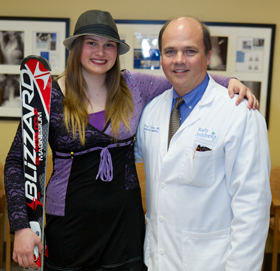
Katrina Schaber and Dr. Hank Chambers
Though she came from a skiing family, Katrina Schaber hated the sport. She could not keep up and would get frustrated and cry. And it was not just skiing. Katrina was also falling behind in other ways. She was clumsy and had trouble with balance, walking and running were difficult, and she was having problems in school.
An occupational therapist diagnosed Katrina with dyspraxia, a developmental condition that affects coordination, but Katrina’s mom, Carolina, thought there was more going on. A nurse by training, Carolina left her executive position and began working for Hank Chambers, M.D., who heads Rady Children’s Cerebral Palsy Center and is a professor of clinical orthopedic surgery at UC San Diego. The new position was an incredible stroke of luck.
“By fluke chance I was hired by Rady Children’s, and by
fluke chance I was hired as Dr. Chambers’ nurse,” says Carolina.
It wasn’t long before Katrina came into the center and, within just a few minutes, Dr. Chambers diagnosed her with cerebral palsy, a brain disorder that affects development and fine motor skills. It was a devastating diagnosis, but it also pointed the way forward.
“Finally, we had an answer after trying to figure it out for so long,” says Carolina.
The CP Workout
Katrina was lucky; her cerebral palsy was relatively mild, but she still had to work hard to overcome it.
“Exercise is essential,” says Dr. Chambers. “The stronger these kids are, the better their outcomes.”
Katrina began a rigorous physical therapy and stretching regimen. After finishing her homework, when other kids might be watching TV or playing games, she had to work: learning how to hop, skip
and cut in a straight line. There were also surgeries to correct Katrina’s knock knees and improve her gait.
Hitting the Slopes
Dr. Chambers recommended an adaptive ski program through Denver Children’s Hospital and the National Sport Center for the Disabled. The results were magical. When she came home, Katrina said, “Mom, they got me.”
Katrina became progressively better at handling her CP and skiing. Both her confidence and her grades improved. An award-winning athlete, she now trains with Team Summit/Adaptive Adventures and is working towards skiing in the 2014 Paralympics. CP is still a barrier, but one she is eager to overcome.
Recently, Katrina was skiing with her mom and took off down the slope. She had her skis off before Carolina even finished her run.
“When I was first diagnosed, I thought it was the end of the world,” says Katrina. “But I learned to live with it, and it kind of made me who I am.”
Pioneering CP Treatments
The Southern California Cerebral Palsy Center at Rady Children’s is one of the premier cerebral palsy (CP) centers in the word. For more than 30 years, the Center has helped develop new surgeries and other therapies to help people overcome their CP.
The neural damage that causes cerebral palsy can happen during fetal development or in very early childhood. The condition can cause seizures, cognitive disability, attention deficit and other issues. Because the damage interferes with neural signals, muscles get tight and do not function properly.
The Center has pioneered a variety of surgeries, including acetabuloplasty, a procedure to help correct bone and joint problems. Its world-class gait training facility inspired the motion-capture technologies at Pixar and other studios. The team has also investigated new techniques to fight muscle spasticity, such as using botulinum toxin.
Recently, the Center began collaborating with Dr. Richard Lieber at UC San Diego to study how CP affects muscles. These investigations may lead to treatments that prevent muscle contractures and decrease the need for surgery.
Originally published in the Summer 2013 issue of Rady Children’s Magazine